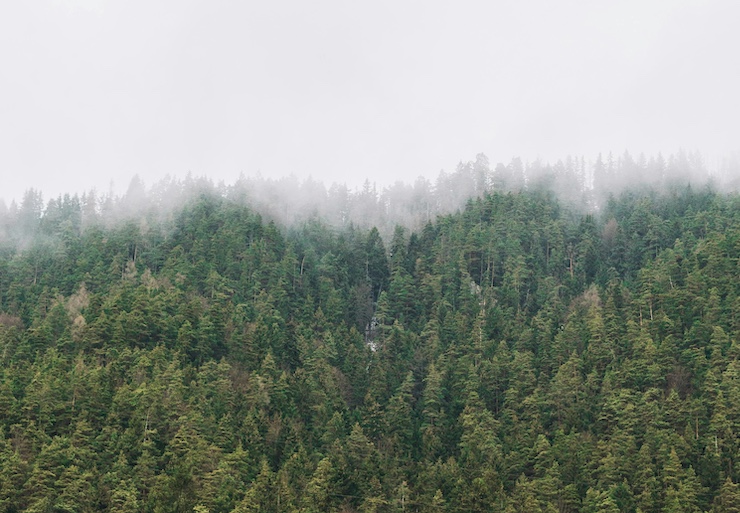
One could say that KC Kushman was destined to work at the Tennessee Oak Ridge National Laboratory (ORNL) since she was a child. Raised in the community, both of her parents were ecologists who worked at the lab, and her brother went on to become an engineer there as well. KC was fortunate to have teachers in middle and high school who encouraged her to embrace her interests in math, science, and technology, introducing her to student summer programs at ORNL.
When it was time to attend college, KC ventured out of Tennessee. She earned her B.A. in Biology and Engineering at Pennsylvania’s Swarthmore College before earning a Master’s and Ph.D. in Ecology and Evolutionary Biology from Rhode Island’s Brown University. Combining her childhood experiences, personal interests, and educational background led KC to conduct groundbreaking research with the Smithsonian Tropical Research Institute, where she had the opportunity to get up close to forest systems. Her research focused on analyzing forest health and the impact of this health metric on global conditions. While she loved being up close with the trees, KC said she often felt dissatisfied with the research process, recognizing that technology like drones would allow her to gather data on a far more comprehensive scale.
After putting in some more fieldwork, particularly on the engineering side as a Postdoctoral Fellow at NASA’s Jet Propulsion Laboratory in California, KC finally had the opportunity to return to her roots in 2023 as a Liane B. Russell Fellow in the Ecosystem Processes Group and Environmental Sciences Division at ORNL. Since joining ORNL, KC has been using drones equipped with LiDAR sensing systems to gather carbon data from forests in the Southeastern United States and South America.
She explains that drones allow her to gain a complete understanding of a forest in a way that wasn’t feasible through manual measurements on the ground. “To understand carbon and forests, you really have to think about individual trees — how tall they are, how big the trunks are, how they angle their leaves — but you also have to think about communities of trees — how different species compete with each other, how they’re influenced by storms and soils, and how they’re affected by longer-term climate trends,” she said. “I can use remote-sensing tools to look at both individual trees and larger-scale patterns over time and get a picture of how ecosystems are functioning and changing.”
Acting on behalf of ORNL, KC recently had the opportunity to once again collaborate with NASA’s Jet Propulsion Laboratory to examine how forests in Brazil have begun to contribute more to carbon emissions rather than act as a carbon sink. It is widely acknowledged that the degradation of forests due to legal and illegal logging, urbanization, and wildfires, to name a few, has made it so that these natural carbon sinks work less efficiently.
However, the research team wanted to quantify whether these ecosystems, which have been threatened, are now doing the opposite of their natural functions and contributing to carbon loss by emitting carbon into the atmosphere. “Accurately attributing the sources of carbon loss to forest degradation and natural disturbances remains a challenge because of the difficulty of classifying disturbances and simultaneously estimating carbon changes,” the team explains in their research paper. “We used a unique, randomized, repeated, very high-resolution airborne laser scanning survey to provide a direct, detailed, and high-resolution partitioning of aboveground carbon gains and losses in the Brazilian Arc of Deforestation.”
In the paper, titled A Large Net Carbon Loss Attributed to Anthropogenic and Natural Disturbances in the Amazon Arc of Deforestation, KC and the team reveal that of the 90.5 million metric tons of carbon being released from the Amazon Arc of Deforestation, 60 million metric tons came from forest degradation (the initial stage of deforestation), while 24 million metric tons of carbon loss were attributed to deforestation. The team also found that areas of the forest actively protected by indigenous peoples produced the least carbon loss, though these areas are under constant threat of degradation from external factors.
The paper concludes by stating, “Our results significantly advance our understanding of degradation in tropical forests and its implications for the carbon budget, highlighting the need for improved and continued high-resolution monitoring of forest structure and assessment of forest disturbances and recovery.” With the data collected in Brazil supporting the benefits of drone-based forest studies, KC is now continuing the research in the United States. The ultimate goal is to present drone-supported data that can be used to implement strategies for minimizing degradation, which could eventually lead to halting deforestation and strengthening carbon sinks rather than losses.
|